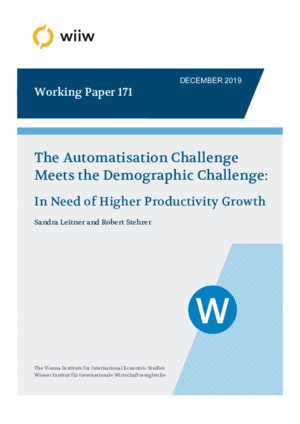The Automatisation Challenge Meets the Demographic Challenge: In Need of Higher Productivity Growth
Sandra M. Leitner and Robert Stehrer
wiiw Working Paper No. 171, December 2019
24 pages including 5 Tables and 4 Figures
The future of employment and labour demand growth in the dawning era of intelligent robots and other new technologies is heavily debated. This paper argues that this discussion needs to be complemented by a second trend which has been unfolding in Europe for some time, namely the demographic decline. Various demographic scenarios for many EU countries point towards a significant decline in the working-age population in the near future which puts the functioning of labour markets at risk as labour shortages become increasingly more likely and subsequently threaten economic growth. In this context, this paper gives an overview of recent trends in the growth of real value added, labour productivity and employment as well as of demographic scenarios. Based on these trends, the hypothetical increase of labour productivity growth which would be required to keep real GDP growth at its current level, despite the projected reduction in the workforce, is calculated. Results show that the hypothetical labour productivity growth rate required is about one percentage point higher than the actual growth rate, suggesting that the current labour productivity growth rate in the EU needs to more than double. A complementary econometric analysis shows that even though robots exhibit a positive impact on labour productivity growth, this is not (yet) strong enough to close the gap between the recent and the hypothetical labour productivity trend growth rate which would be required.
Disclaimer:
The paper has been written as part of the DG ECFIN FELLOWSHIP-INITIATIVE 2018-2019: The productivity challenge: jobs and incomes in the dawning era of intelligent robots, Ref. 2018 ECFIN 005/B and can also be downloaded from the European Commission's website.
Keywords: robotisation, ICT capital, productivity, demography
JEL classification: J11, O33, O47
Countries covered: European Union
Research Areas: Macroeconomic Analysis and Policy, Labour, Migration and Income Distribution
